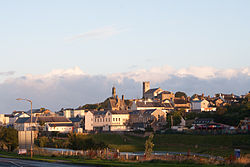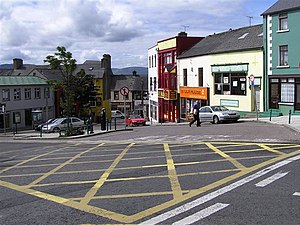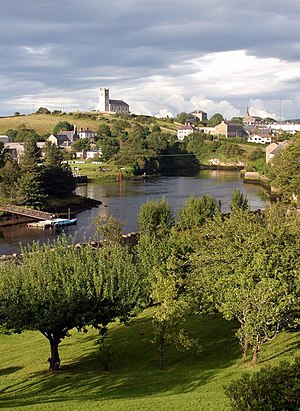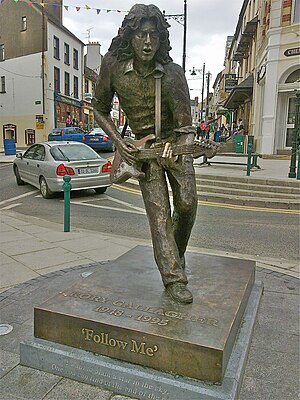Ballyshannon: Difference between revisions
Created page with "{{Infobox town |county=Donegal |irish=Béal Átha Seanaidh |picture=Ballyshannon in the Morning Sun 2012 09 17.jpg |picture caption= Ballyshannon as seen from the Beleek Road..." |
m →History: clean up, replaced: medieval → mediæval |
||
| (One intermediate revision by the same user not shown) | |||
| Line 24: | Line 24: | ||
==History== | ==History== | ||
Archaeological sites dating as far back as the Neolithic period (4000 BC – 2500 BC) have been excavated in Ballyshannon and surrounding areas, representing settlement and ritual activity from early periods of human settlement. Finds have ranged from ''fulachta fiadh'' (burnt mounds) dating from the Bronze Age (2500–500 BC), to a possible brushwood trackway thought to date to an earlier Neolithic period, to the recent discovery of a previously unknown | Archaeological sites dating as far back as the Neolithic period (4000 BC – 2500 BC) have been excavated in Ballyshannon and surrounding areas, representing settlement and ritual activity from early periods of human settlement. Finds have ranged from ''fulachta fiadh'' (burnt mounds) dating from the Bronze Age (2500–500 BC), to a possible brushwood trackway thought to date to an earlier Neolithic period, to the recent discovery of a previously unknown mediæval church and cemetery containing hundreds of skeletons thought to date from between 1100 and 1400. This site yielded numerous artefacts including silver long cross pennies and halfpennies dating from the reign of Henry III (1251–1276) and Edward I (c.1280–1302). Other finds included bone beads, shroud pins, and pieces of quartz which were found placed in the hands of many of the skeletons. | ||
Numerous other sites from various periods are thought to exist, including a neolithic tomb, and the grave of Aed Ruad, High King of Ireland, upon which St | Numerous other sites from various periods are thought to exist, including a neolithic tomb, and the grave of Aed Ruad, High King of Ireland, upon which St Anne's church ([[Church of Ireland]]) was supposedly built, occupying the highest of the town's vantage points—Mullgoose. Nothing remains to mark either tomb, the last vestige of the mound on Mullaghnashee having been obliterated in 1798 when a fort was constructed on the hill-top. The 18th-century churchyard and the paupers' burial ground were both referred to as ''Sidh Aedh Ruaidh'', the Fairy Mound of Red Hugh. The 'sheeman' (Anglicisation of the Irish ''sidh'') in Mullgoose means 'fairies'. Popular belief assigned the interior of hills to fairies' dwelling places and local tradition has handed down accounts of the exploits of the fairy folk, especially among the Finner sand-hills and in the Wardtown district of Ballyshannon. | ||
[[File:Ballyshannon.jpg|thumb|[[Lough Erne]] and Ballyshannon.]] | [[File:Ballyshannon.jpg|thumb|[[Lough Erne]] and Ballyshannon.]] | ||
Latest revision as of 10:49, 30 January 2021
| Ballyshannon Irish: Béal Átha Seanaidh | |
| County Donegal | |
|---|---|
 Ballyshannon as seen from the Beleek Road | |
| Location | |
| Grid reference: | G876614 |
| Location: | 54°30’5"N, 8°11’24"W |
| Data | |
| Population: | 2,504 (2011) |
| Post town: | Ballyshannon |
| Postcode: | F94 |
| Dialling code: | 071 |
| Local Government | |
| Council: | Donegal |
| Dáil constituency: |
Donegal |
| Website: | http://www.ballyshannon.ie |
Ballyshannon is a town in County Donegal, located at the southern end of the county where the N3 and N15 roads cross the River Erne. It claims to be the oldest town in Ireland.[1][2][3][4]
Location

Ballyshannon, which means "The Mouth of Seannach's Ford", after a fifth-century warrior, Seannach, who was slain there, lies at the mouth of the river Erne. Just west of the town, the Erne widens and its waters meander over a long sandy estuary. The northern bank of the river rises steeply away from the riverbank, while the southern bank is flat with a small cliff that runs parallel to the river. From its idyllic setting, the town looks out over the estuary and has panoramic views of mountains, lakes and forests.
History
Archaeological sites dating as far back as the Neolithic period (4000 BC – 2500 BC) have been excavated in Ballyshannon and surrounding areas, representing settlement and ritual activity from early periods of human settlement. Finds have ranged from fulachta fiadh (burnt mounds) dating from the Bronze Age (2500–500 BC), to a possible brushwood trackway thought to date to an earlier Neolithic period, to the recent discovery of a previously unknown mediæval church and cemetery containing hundreds of skeletons thought to date from between 1100 and 1400. This site yielded numerous artefacts including silver long cross pennies and halfpennies dating from the reign of Henry III (1251–1276) and Edward I (c.1280–1302). Other finds included bone beads, shroud pins, and pieces of quartz which were found placed in the hands of many of the skeletons.
Numerous other sites from various periods are thought to exist, including a neolithic tomb, and the grave of Aed Ruad, High King of Ireland, upon which St Anne's church (Church of Ireland) was supposedly built, occupying the highest of the town's vantage points—Mullgoose. Nothing remains to mark either tomb, the last vestige of the mound on Mullaghnashee having been obliterated in 1798 when a fort was constructed on the hill-top. The 18th-century churchyard and the paupers' burial ground were both referred to as Sidh Aedh Ruaidh, the Fairy Mound of Red Hugh. The 'sheeman' (Anglicisation of the Irish sidh) in Mullgoose means 'fairies'. Popular belief assigned the interior of hills to fairies' dwelling places and local tradition has handed down accounts of the exploits of the fairy folk, especially among the Finner sand-hills and in the Wardtown district of Ballyshannon.

The Vikings, according to the Annals of Ulster, attacked nearby Inishmurray Island in 795. Later they used the River Erne to attack inland, burning Devenish Island Monastery in 822. The Annals also record that in 836, all the churches of Loch Erne, together with Cluain Eois (Clones) and Daimhinis (Devenish Island) were destroyed by the "gentiles". In 923 and 916 respectively, "a fleet of foreigners on Loch Erne plundered the islands of the lake", as well as the surrounding territories.
In 1775 the salmon-leap of Assaroe at Ballyshannon was praised by the traveller Richard Twiss in A Tour in Ireland[5] (p. 157):
The Giants Causeway is an object which is scarcely worthy of going so far to see; however that is to be determined by the degree of curiosity of which the traveller is possessed. But the salmon-leap at Ballyshannon is a scene of such a singular nature, as is not to be found elsewhere, and is as peculiar to Ireland as the bullfights are to Spain.....
It was in Ballyshannon, around 1793, that Viscount Castlereagh, the future Chief Secretary for Ireland and, later, British Foreign Secretary, had his famous vision of the radiant boy. Known at the time as The Hon. Robert Stewart (he became Lord Castlereagh in 1796), he was serving as a young Army officer and M.P. for Down in the Irish Parliament at the time. Lodging in the old Military Barracks in the town, Stewart (as he then was) retired for the night. Looking into the fire he saw the form of a boy emerge from the flames, grow larger and larger and vanish.[6] The radiant boy is a well-known figure in English and Irish folklore, and is often supposed to foretell death. William Allingham later wrote a poem about the incident.[7]
The Enniskillen and Bundoran Railway (E&BR) opened in 1868 and had a station at Ballyshannon.[8] The Great Northern Railway (GNR) operated the E&BR line from 1876 and absorbed the company in 1896.[9] The partition of Ireland in 1922 turned the boundary with Fermanagh into an international frontier. Henceforth Ballyshannon's only railway link with the rest of the Irish Free State was via Northern Ireland, and as such was subject to delays for customs inspections. The Government of Northern Ireland closed much of the GNR network on its side of the border in 1957, including the E&BR as far as the border.[10][11] This gave the Republic no practical alternative but to allow the closure of the line through Ballyshannon between the border and Bundoran. Thereafter the nearest railheads for Ballyshannon were Sligo in the Republic and Omagh in Northern Ireland, until in 1965 the Ulster Transport Authority closed the line through Omagh as well.[10][12]
A hydroelectric power station was built in the town in the 1950s. The project, or 'Scheme' as it was then referred to, brought engineers, electricians, and specialists in hydroelectricity from many parts of the country and abroad to the town, which experienced a boom during the decade-long construction period. This involved building a dam upriver from the town at Cathleen's Falls (also known as Assaroe Falls) and digging out a deep channel to lower the riverbed through the town to increase the head of water at the dam to drive the turbines. Before the station was built, the river was wide, and the water level much higher than it is today. A long bridge spanned from the northern shore to the 'port' on the southern bank. The waters spilled over a number of waterfalls, among them Cathleen's Falls, before meandering out to sea. Today, however, the river runs through a narrow channel, far below the level of either bank and a narrower single arch bridge has replaced the old one. The newly built Ballyshannon – Bundoran bypass has added a new, more modern bridge over the river. A pedestrian bridge was also constructed to mark the millennium.
During the Second World War the British and Irish governments quietly reached an agreement to create an air corridor between nearby Belleek and Ballyshannon, the "Donegal Corridor", which was used by British Royal Air Force flights from Northern Ireland into the Atlantic Ocean.[13] This was used by the aircraft which located the German battleship Bismarck.[14]
Local attractions
- The Rory Gallagher International Tribute Festival[15] takes place in Ballyshannon on June Bank Holiday weekend.
- Ballyshannon Folk Festival[16] takes place every year on the August bank holiday weekend.
Transport and communications
Buses run to cities and major towns in Ireland including Cavan and Dublin, Belfast and Londonderry. Services are also provided to and from Gweedore to the west of Ireland, including Sligo and Galway, via Ballyshannon.
The nearest railway to Ballyshannon is Sligo station which is served by trains to Dublin.[17]
Notable people

The Gallagher clan, originated in the barony of Tirhugh to the north of Ballyshannon. The guitarist and singer Rory Gallagher was born in Ballyshannon and the town centre contains a statue (pictured right) erected in his memory. The Rory Gallagher statue is sometimes dressed in a Donegal jersey.[18]
- Others born here include
- William Allingham, poet
- Mark Boyle, economic activist
- Charlie McGettigan, singer and Eurovision Song Contest winner
- Hazel (Corscadden) Blair, mother of British Prime Minister Tony Blair[19]
- Charlotte Mathilda Blake Thornley (1818–1901), mother of novelist and short story writer Bram Stoker.[20]
Sport
- The local Gaelic Athletic Association club is Aodh Ruadh.
- The local rugby club is Ballyshannon R.F.C.
- The local association football club is Erne Wanderers.
- The local Basketball club is the Eightyeighters
References
- ↑ "Ballyshannon Donegal Ireland - Hotels, B&B, Hostels, Self Catering, Guesthouse Holiday Accommodation". accommodation.ie. http://www.accommodation.ie/donegal/ballyshannon.htm.
- ↑ http://www.discoverireland.com/us/ireland-places-to-go/placefinder/b/ballyshannon-donegal/
- ↑ "About Creevy Experience Ballyshannon, Creevy Co-operative Ltd". creevyexperience.com. http://www.creevyexperience.com/about-creevy-experience-accommodation-donegal.html.
- ↑ "An Error has occurred". donegaldirect.com. http://donegaldirect.com/ws_business_details.aspx?BusinessID=1920&Region=Ballyshannon&BusinessNm=Ballyshannon+Cycle+Hub.
- ↑ "A tour in Ireland in 1775". google.ie. https://books.google.com/books?id=ujpIAAAAMAAJ.
- ↑ Hyde, Montgomery The Strange Death of Lord Castlereagh William Heinemann 1959 pp.161–2
- ↑ Hyde, p.162
- ↑ Hajducki, S. Maxwell (1974). A Railway Atlas of Ireland. Newton Abbott: David & Charles. map 6. ISBN 0-7153-5167-2.
- ↑ Hajducki, op. cit., page xiii
- ↑ 10.0 10.1 Hajducki, op. cit., map 39
- ↑ McCutcheon, Alan (1970). Ireland. Railway History in Pictures. 2. Newton Abbott: David & Charles. pp. 153, 207. ISBN 0-7153-4998-8.
- ↑ McCutcheon, 1970, pages 155, 209
- ↑ Guidera, Anita (19 April 2007). "Plaques mark secret wartime air corridor in Donegal". Irish Independent. http://www.independent.ie/national-news/plaques-mark-secret-wartime-air-corridor-in-donegal-44249.html. Retrieved 4 September 2008.
- ↑ Kennedy, Ludovic (1975). Pursuit: The Sinking of the Bismarck. London: Book Club Associates. p. 137. ISBN 0-00-634014-8.
- ↑ "RORY GALLAGHER INTERNATIONAL FESTIVAL 2015 - Ballyshannon, Co. Donegal, Ireland - Thursday 28th May to Sunday 31st May 2015". RORY GALLAGHER INTERNATIONAL FESTIVAL 2015 - Ballyshannon, Co. Donegal, Ireland - Thursday 28th May to Sunday 31st May 2015. http://www.rorygallagherfestival.com.
- ↑ "Ballyshannon Folk & Traditional Music Festival. Donegal Ireland. - – Mad For Trad". ballyshannonfolkfestival.com. http://www.ballyshannonfolkfestival.com.
- ↑ "Ireland rail travel information - Iarnród Éireann - Irish Rail". Irish Rail. http://www.irishrail.ie.
- ↑ "Rory's rocking again for Donegal". Donegal Democrat. 20 September 2012. http://www.donegaldemocrat.ie/news/local/rory-s-rocking-again-for-donegal-1-4285490. Retrieved 20 September 2012.
- ↑ "Local Map". http://www.ballyshannon.ie/Article_Listings.aspx?tscategory_id=276&category_name=Local+Map.
- ↑ http://www.donegalhistory.com/old/DA57.pdf
Outside links
| ("Wikimedia Commons" has material about Ballyshannon) |
